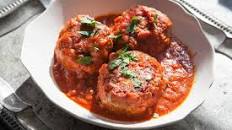Savoury Delights: Elevate Your Menu with a Tantalising Turkey Burger Recipe

The Perfect Turkey Burger Recipe
Looking for a healthier alternative to beef burgers? Try making juicy and flavourful turkey burgers at home! This recipe is easy to follow and guarantees a delicious meal for you and your family.
Ingredients:
- 500g ground turkey
- 1/4 cup breadcrumbs
- 1 small onion, finely chopped
- 2 cloves garlic, minced
- 1 teaspoon paprika
- 1 teaspoon dried oregano
- Salt and pepper to taste
- 4 burger buns
- Lettuce, tomato, cheese (optional toppings)
Instructions:
- In a mixing bowl, combine the ground turkey, breadcrumbs, chopped onion, minced garlic, paprika, oregano, salt, and pepper. Mix well until all ingredients are evenly incorporated.
- Divide the mixture into 4 equal portions and shape them into burger patties of your desired thickness.
- Heat a grill or non-stick pan over medium heat. Cook the turkey burgers for about 5-6 minutes per side or until fully cooked through.
- To assemble the burgers, place each cooked patty on a bun. Add lettuce, tomato slices, cheese (if using), and any other toppings of your choice.
- Serve hot with a side of crispy fries or a fresh salad. Enjoy your homemade turkey burgers!
This turkey burger recipe is not only delicious but also a healthier option for those looking to cut down on red meat. Feel free to customise the seasonings and toppings to suit your taste preferences. Bon appétit!
9 Essential Tips for Perfecting Healthy and Delicious Turkey Burgers
- Use lean ground turkey for a healthier option.
- Add grated vegetables like zucchini or carrots to keep the burgers moist.
- Season the patties well with herbs and spices for flavour.
- Cook the burgers on a preheated grill or non-stick pan for best results.
- Avoid overcooking to prevent dryness; cook until internal temperature reaches 165°F (74°C).
- Consider adding binding agents like breadcrumbs or egg to help hold the patties together.
- Serve the turkey burgers on whole grain buns for added fibre and nutrients.
- Top with fresh toppings like lettuce, tomato, and avocado for extra freshness.
- Experiment with different condiments such as mustard, ketchup, or tzatziki sauce for variety.
Use lean ground turkey for a healthier option.
For a healthier twist on your turkey burger recipe, opt for lean ground turkey. Choosing lean meat not only reduces the overall fat content of the burger but also provides a lighter and healthier alternative to traditional beef burgers. Lean ground turkey is lower in saturated fats, making it a smart choice for those looking to enjoy a delicious meal without compromising on their health goals. Incorporating lean protein into your diet through recipes like turkey burgers can help you maintain a balanced and nutritious eating plan.
Add grated vegetables like zucchini or carrots to keep the burgers moist.
Enhance the juiciness and flavour of your turkey burgers by incorporating grated vegetables such as zucchini or carrots into the mixture. Not only do these veggies add moisture to the patties, but they also contribute a subtle sweetness and extra nutrients to your meal. The grated vegetables blend seamlessly with the ground turkey, creating a delicious and healthier burger option that will surely impress your taste buds.
Season the patties well with herbs and spices for flavour.
To enhance the taste of your turkey burgers, it is essential to season the patties generously with a blend of herbs and spices. Adding a mixture of aromatic seasonings like paprika, oregano, and garlic not only infuses the patties with rich flavours but also elevates the overall dining experience. By taking the time to season your turkey burger patties thoughtfully, you can create a dish that is bursting with delicious and satisfying tastes that will impress your taste buds with every bite.
Cook the burgers on a preheated grill or non-stick pan for best results.
For the best results when preparing turkey burgers, it is recommended to cook them on a preheated grill or non-stick pan. By ensuring that the cooking surface is properly heated before adding the burgers, you can achieve a deliciously charred exterior while locking in the juicy flavours of the meat. This method helps to create a perfectly cooked turkey burger with a nice sear, adding depth and texture to each bite. Cooking on a preheated surface also helps prevent sticking and ensures even cooking throughout.
Avoid overcooking to prevent dryness; cook until internal temperature reaches 165°F (74°C).
When preparing turkey burgers, it is crucial to avoid overcooking them to prevent dryness. To ensure a juicy and flavourful outcome, cook the burgers until the internal temperature reaches 165°F (74°C). This temperature not only guarantees that the burgers are safe to eat but also helps retain their moisture, resulting in a delicious and satisfying meal for you and your loved ones. Remember, cooking with care and precision can make all the difference in achieving the perfect turkey burger.
Consider adding binding agents like breadcrumbs or egg to help hold the patties together.
When preparing turkey burgers, it is advisable to consider incorporating binding agents such as breadcrumbs or eggs into the mixture. These ingredients serve to enhance the texture and help bind the patties together, preventing them from falling apart during cooking. By adding breadcrumbs or egg, you can ensure that your turkey burgers maintain their shape and juiciness, resulting in a more satisfying dining experience.
Serve the turkey burgers on whole grain buns for added fibre and nutrients.
For an extra boost of fibre and nutrients, consider serving the turkey burgers on whole grain buns. Whole grains offer a range of health benefits, including improved digestion and a good source of essential nutrients. By making this simple swap, you can elevate the nutritional value of your meal while enjoying the delicious flavours of the turkey burgers.
Top with fresh toppings like lettuce, tomato, and avocado for extra freshness.
Enhance the flavours of your turkey burger by adding a touch of freshness with crisp lettuce, juicy tomato slices, and creamy avocado. These fresh toppings not only provide a burst of flavour but also add a delightful texture to your burger. Elevate your dining experience and enjoy a healthier twist on this classic dish with the vibrant combination of these wholesome ingredients.
Experiment with different condiments such as mustard, ketchup, or tzatziki sauce for variety.
For added variety and flavour to your turkey burgers, consider experimenting with a range of condiments such as mustard, ketchup, or tzatziki sauce. These condiments can enhance the taste profile of your burgers and offer a different culinary experience with each variation. Whether you prefer a classic combination or wish to explore new flavour combinations, the choice of condiments can elevate your turkey burger to a whole new level of deliciousness.


